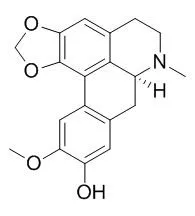| In vitro: |
| Molecules. 2012 Apr 5;17(4):4197-208. | | (-)-Kunstleramide, a new antioxidant and cytotoxic dienamide from the bark of Beilschmiedia kunstleri gamble.[Pubmed: 22481540] |
METHODS AND RESULTS:
A new dienamide, (2E,4E)-7-(3',4'-dimethoxyphenyl)-N-ethyl-6-(R)-hydroxyhepta- 2,4-dienamide, named (-)-kunstleramide (1), were isolated from the bark of Beilschmiedia kunstleri Gamble together with one neolignan: (+)-kunstlerone (2) and seven known alkaloids: (+)-nornuciferine (3), (-)-isocaryachine (4), (+)-Cassythicine (5), (+)-laurotetanine (6), (+)-boldine (7), noratherosperminine (8), (+)-N-demethylphyllocaryptine (9).
Their structures were established from spectroscopic techniques, most notably 1D- and 2D-NMR, UV, IR, OR, circular dichroism (CD) spectra and LCMS-IT-TOF.
CONCLUSIONS:
(-)-Kunstleramide (1) exhibited very poor dose-dependent inhibition of DPPH activity, with an IC₅₀ value of 179.5 ± 4.4 μg/mL, but showed a moderate cytotoxic effect on MTT assays of A375, A549, HT-29, PC-3 and WRL-68 with EC₅₀ values of 64.65, 44.74, 55.94, 73.87 and 70.95 µg/mL, respectively. | | Molecules. 2011 Apr 13;16(4):3119-27. | | Lancifoliaine, a new bisbenzylisoquinoline from the bark of Litsea lancifolia.[Pubmed: 21490559] |
METHODS AND RESULTS:
A new bisbenzylisoquinoline, lancifoliaine (1), together with seven known alkaloids--N-allyllaurolitsine (2), reticuline (3), actinodaphnine, norboldine, pallidine, Cassythicine and boldine--were isolated from the stem bark of Litsea lancifolia (Lauraceae). In addition to that of lancifoliaine, complete ¹³C-NMR data of N-allyl-laurolitsine (2) was also reported. The alkaloidal structures were elucidated by means of high field 1D- and 2D-NMR IR, UV, and LCMS-IT-TOF spectral data.
CONCLUSIONS:
N-Allyllaurolitsine (2) showed a moderate vasorelaxant activity on isolated rat aorta. | | J Nat Prod. 1998 Apr;61(4):480-4. | | Antipoliovirus structure-activity relationships of some aporphine alkaloids.[Pubmed: 9584402] |
METHODS AND RESULTS:
A series of 18 aporphinoids have been tested in vitro against human poliovirus. The aporphines (+)-glaucine fumarate (1), (+)-N-methyllaurotetanine (4), (+)-isoboldine (7), and (-)-nuciferine, HCl (10) were found to be active with selectivity indices > 14. The nature of the 1, 2-substituents of the isoquinoline moiety appeared to be critical for antipoliovirus activity. An SAR study demonstrated the importance of a methoxyl group at C-2 on the tetrahydroisoquinoline ring for the induction of antipoliovirus activity.
CONCLUSIONS:
Molecular modeling of some compounds in this series revealed the close similarities between the three-dimensional conformational features of the inactive 1,2-substituted derivatives (+)-boldine (6) and (+)-laurolitsine (5) with derivatives containing the 1,2-(methylenedioxy) moiety, which were generally found to be inactive as exemplified by (+)-Cassythicine (9). |
|






 Cell. 2018 Jan 11;172(1-2):249-261.e12. doi: 10.1016/j.cell.2017.12.019.IF=36.216(2019)
Cell. 2018 Jan 11;172(1-2):249-261.e12. doi: 10.1016/j.cell.2017.12.019.IF=36.216(2019) Cell Metab. 2020 Mar 3;31(3):534-548.e5. doi: 10.1016/j.cmet.2020.01.002.IF=22.415(2019)
Cell Metab. 2020 Mar 3;31(3):534-548.e5. doi: 10.1016/j.cmet.2020.01.002.IF=22.415(2019) Mol Cell. 2017 Nov 16;68(4):673-685.e6. doi: 10.1016/j.molcel.2017.10.022.IF=14.548(2019)
Mol Cell. 2017 Nov 16;68(4):673-685.e6. doi: 10.1016/j.molcel.2017.10.022.IF=14.548(2019)